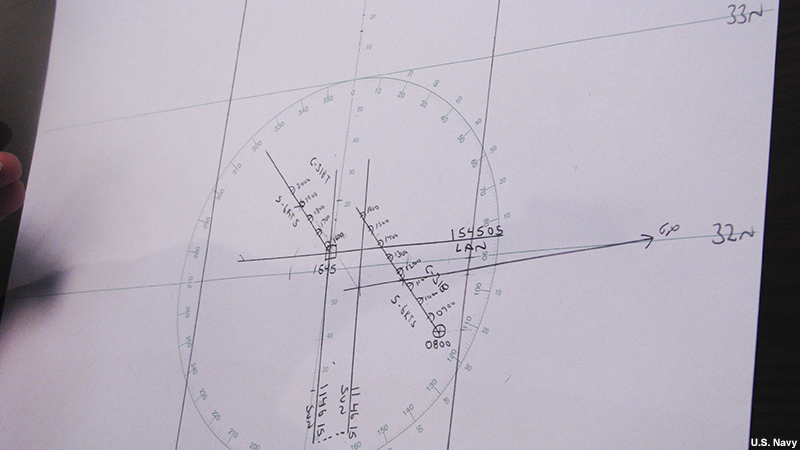A Day in the Life of a Navigator » Advancing a LOP
Advanced lines of position can provide position information when making simultaneous observations of multiple objects is impossible. Between the morning and LAN Sun observations, our course was approximately 318° and speed 6 knots. Using these values, Chief Sheedy demonstrates advancing the morning Sun line to the time of LAN.

Ideally, we would like three LOPs from simultaneous observations to obtain a fix. However, sometimes making three simultaneous observations is impossible. For example, during daytime, we only have one object, the Sun, that is observed. We need to wait a few hours in between observations. We can, in fact, use observations, and their resulting LOPs, that are separated by a considerable amount of time. The procedure is called advancing a line of position.

The details of advancing LOPs are beyond the scope of this module, but conceptually, to use an LOP from an earlier sight, we must take into account how our ship moved since the earlier sight was taken. Similar to getting our DR, we use the ship's ordered speed and course between the times of the LOPs to get the distance and direction the ship should have traveled. Next, we move the earlier LOP parallel to itself by this amount.
For our example, the morning Sun line was taken at 11:46, and the LAN sight was at 15:45. Our ordered direction and speed remained constant at 317.8 degrees and 5.7 knots. Between the two sights, we therefore should have gone 22.8 miles at a heading 317.8 degrees. On our chart, we advance our morning LOP this distance and direction, being sure to move the LOP parallel with itself.
Chief Sheedy: We’ll briefly discuss advancing lines of position. Since there’s only one celestial body available during the day, we’re going to take the morning Sun line and advance it to the local apparent noon latitude. The reason we need to advance it is because four hours have elapsed and the Sun line is where it would be at 11:45. In order to see where it would be at 15:45, you would advance it taking into account the ship’s ordered course and speed, which is 318 6 knots.
In order to advance the Sun line from 11:45 and 15 seconds, just advance it 318 6 knots. We would do that by the course and speed: 318, and draw very lightly because we’re just advancing the LOP at this position. Mark the distance we would travel based on 6 knots. We advance the LOP over to that position, to that tick mark. Where the lines intersect, label 11:46 15 seconds. I like to take hash marks to show that I advanced the LOP over. That’s how you advance an LOP.